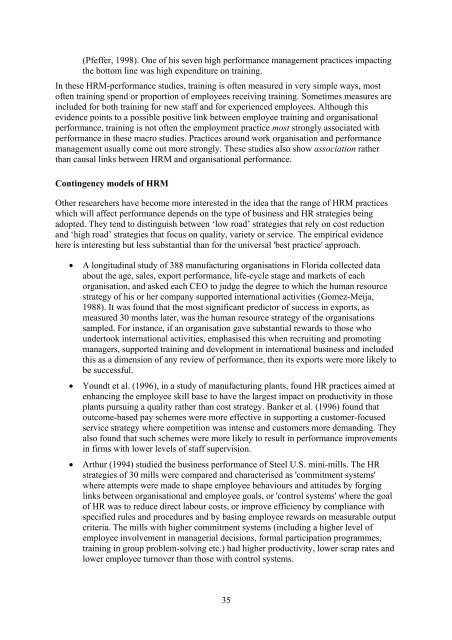The Development of Management and Leadership Capability and its ...
The Development of Management and Leadership Capability and its ...
The Development of Management and Leadership Capability and its ...
Create successful ePaper yourself
Turn your PDF publications into a flip-book with our unique Google optimized e-Paper software.
(Pfeffer, 1998). One <strong>of</strong> his seven high performance management practices impacting<br />
the bottom line was high expenditure on training.<br />
In these HRM-performance studies, training is <strong>of</strong>ten measured in very simple ways, most<br />
<strong>of</strong>ten training spend or proportion <strong>of</strong> employees receiving training. Sometimes measures are<br />
included for both training for new staff <strong>and</strong> for experienced employees. Although this<br />
evidence points to a possible positive link between employee training <strong>and</strong> organisational<br />
performance, training is not <strong>of</strong>ten the employment practice most strongly associated with<br />
performance in these macro studies. Practices around work organisation <strong>and</strong> performance<br />
management usually come out more strongly. <strong>The</strong>se studies also show association rather<br />
than causal links between HRM <strong>and</strong> organisational performance.<br />
Contingency models <strong>of</strong> HRM<br />
Other researchers have become more interested in the idea that the range <strong>of</strong> HRM practices<br />
which will affect performance depends on the type <strong>of</strong> business <strong>and</strong> HR strategies being<br />
adopted. <strong>The</strong>y tend to distinguish between ‘low road’ strategies that rely on cost reduction<br />
<strong>and</strong> ‘high road’ strategies that focus on quality, variety or service. <strong>The</strong> empirical evidence<br />
here is interesting but less substantial than for the universal 'best practice' approach.<br />
• A longitudinal study <strong>of</strong> 388 manufacturing organisations in Florida collected data<br />
about the age, sales, export performance, life-cycle stage <strong>and</strong> markets <strong>of</strong> each<br />
organisation, <strong>and</strong> asked each CEO to judge the degree to which the human resource<br />
strategy <strong>of</strong> his or her company supported international activities (Gomez-Meija,<br />
1988). It was found that the most significant predictor <strong>of</strong> success in exports, as<br />
measured 30 months later, was the human resource strategy <strong>of</strong> the organisations<br />
sampled. For instance, if an organisation gave substantial rewards to those who<br />
undertook international activities, emphasised this when recruiting <strong>and</strong> promoting<br />
managers, supported training <strong>and</strong> development in international business <strong>and</strong> included<br />
this as a dimension <strong>of</strong> any review <strong>of</strong> performance, then <strong>its</strong> exports were more likely to<br />
be successful.<br />
• Youndt et al. (1996), in a study <strong>of</strong> manufacturing plants, found HR practices aimed at<br />
enhancing the employee skill base to have the largest impact on productivity in those<br />
plants pursuing a quality rather than cost strategy. Banker et al. (1996) found that<br />
outcome-based pay schemes were more effective in supporting a customer-focused<br />
service strategy where competition was intense <strong>and</strong> customers more dem<strong>and</strong>ing. <strong>The</strong>y<br />
also found that such schemes were more likely to result in performance improvements<br />
in firms with lower levels <strong>of</strong> staff supervision.<br />
• Arthur (1994) studied the business performance <strong>of</strong> Steel U.S. mini-mills. <strong>The</strong> HR<br />
strategies <strong>of</strong> 30 mills were compared <strong>and</strong> characterised as 'commitment systems'<br />
where attempts were made to shape employee behaviours <strong>and</strong> attitudes by forging<br />
links between organisational <strong>and</strong> employee goals, or 'control systems' where the goal<br />
<strong>of</strong> HR was to reduce direct labour costs, or improve efficiency by compliance with<br />
specified rules <strong>and</strong> procedures <strong>and</strong> by basing employee rewards on measurable output<br />
criteria. <strong>The</strong> mills with higher commitment systems (including a higher level <strong>of</strong><br />
employee involvement in managerial decisions, formal participation programmes,<br />
training in group problem-solving etc.) had higher productivity, lower scrap rates <strong>and</strong><br />
lower employee turnover than those with control systems.<br />
35
















